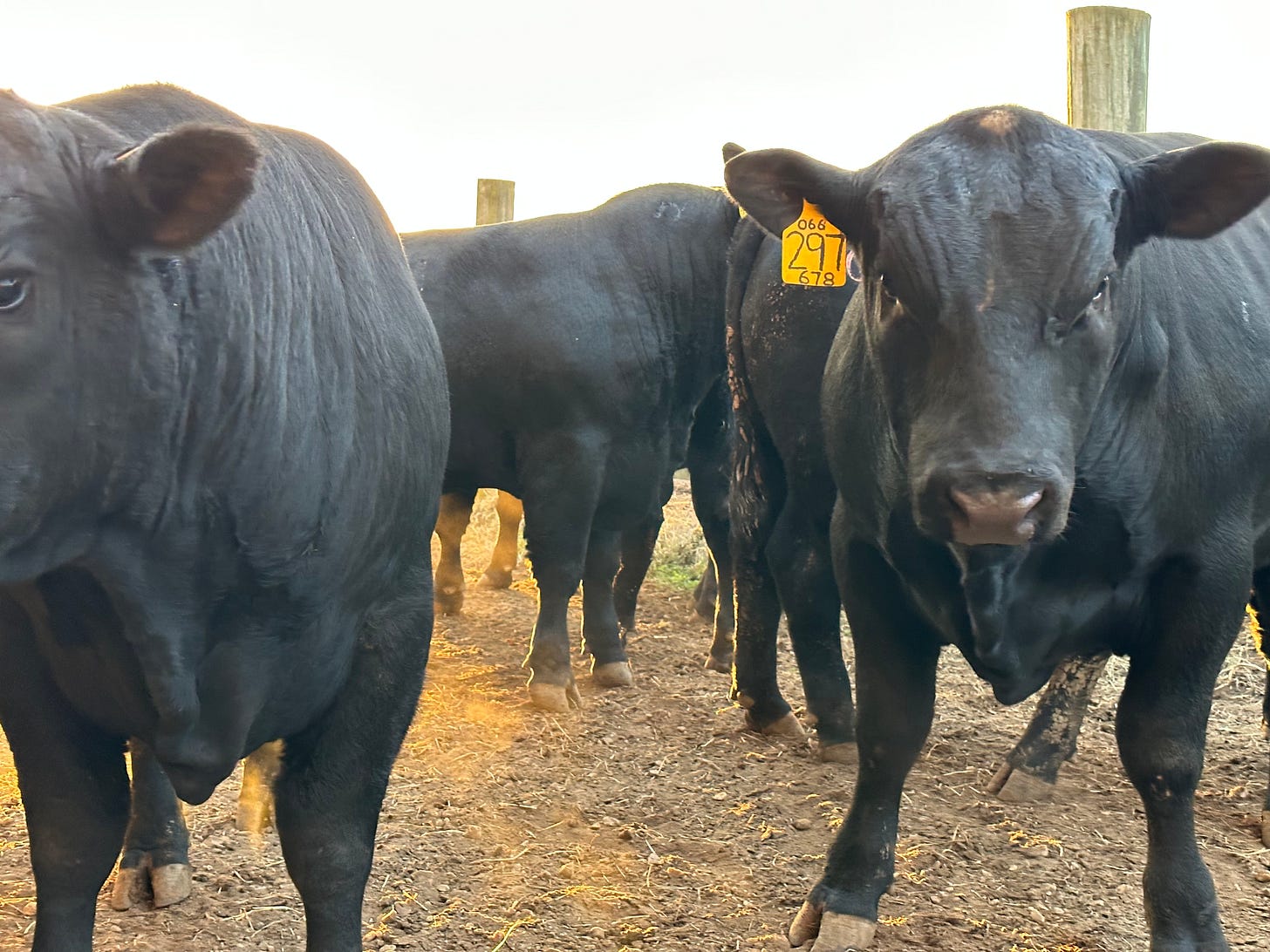A NOT SO AVERAGE DAY IN THE LIFE OF THE RANCHER DOCTOR
ONE NEVER KNOWS WHAT THEY WILL ENCOUNTER EACH DAY IN RURAL MEDICINE
A NOT SO AVERAGE DAY IN THE LIFE OF THE RANCHER DOCTOR:
This past Thursday, I awoke slightly earlier than normal as I wanted to accomplish a few things before going into the office at Miller Family Health and Wellness. Our coming fall yearling bulls needed to be checked before office hours, and I also wanted to get a session of red and near infrared light therapy, which always seems to lift my mood and starts my day energized and optimistic. But unfortunately, in the famous words of Robert Burns, “The best laid plans of mice and men often go awry.”
Not long after my morning shower, I received a phone call from Michele our trusted and valued office manager and receptionist. A patient had arrived an hour earlier than normal office hours complaining of chest pain. I instructed Michele to obtain an EKG and assured her that I would be in within minutes. (Thankfully, Ann and I live only 1.5 miles from the office.)
After rushing to the office, assessing the patient and interpreting her EKG I determined the best course of action was to contact EMS and transport this patient to the nearest emergency department. As in many rural communities, this is a 25-mile drive.
In Rappahannock we are very fortunate to have a dedicated and enthusiastic group of volunteer first responders and EMS personnel. I’ve known many of these fine people most of my life and we are on a first name basis. Shortly after we made the call, paramedic Ann Speaker, was the first to arrive followed by Bobby Smoot and other EMS personnel soon thereafter. I have known Ann since she was a gym teacher at Rappahannock County high school in the 1970s and 80s, and I have known Bobby Smoot since high school as well. Bobby used to live on our farm/ranch with his family and kept the groundhog population at bay. Within minutes, we had the patient stabilized and on her way to Fauquier Hospital
.
My next, and first scheduled patient of the day was an elderly gentleman, whom I am particularly fond. Even though his memory is fading, he always enthusiastically wants to discuss the fact that he and family members invest in and mine Bitcoin. He is quite proud of this endeavor and often encourages me to invest in this freedom currency.
Upon entering the room and after a pleasant greeting, I ask him, “What can I do for you today?” He responds, “I think my sugar dropped and I passed out 3 days ago.” My thought process at the time was while this was certainly possible, it was highly unlikely that he suffered from a hypoglycemic event—he was not on any medication that would put him at high risk for dropping his blood sugar.
His comorbidities include diabetes, hypertension, obesity, atherosclerotic cardiovascular disease with a history of coronary bypass surgery in the remote past. After asking him exactly what happened and what symptoms he had experienced, he described experiencing lightheadedness, followed by collapsing to the floor and became sweaty and diaphoretic, but never losing consciousness. I noted he had had a 10-pound weight gain from his last visit one month earlier (which was very unusual), his heart rate was quite slow at 44 bpm, and he had massive lower extremity pitting edema.
His heart and lung examination revealed him to be in congestive heart failure. An EKG was performed and showed him to be bradycardic (abnormally low heart rate) with the loss of the normal p waves, which initiate normal sinus rhythm / heartbeat. There was further evidence of cardiac ischemia (Lack of adequate oxygen and blood flow to the heart muscle), causing damage to the normal cardiac conduction system resulting in his arrythmia. He was in need of a pacemaker and possibly a coronary stent or bypass surgery.
Once again, EMS was notified. Bobby and Ann just happened to be returning from Fauquier hospital and were only a couple miles away.
I notified his cardiologist and we discussed his case. Off he went via EMS to a different local community hospital for further cardiac testing and pacemaker evaluation. (As of this writing he received both his pacemaker and bypass surgery)
The next patient of the day was more of a success story and quite frankly lifted my mood and spirits. This gentleman was 58 who had initially seen me for the first time three months earlier. He was an overweight, type two diabetic with diabetic peripheral neuropathy, hypertension, Vit D deficiency and low testosterone levels (note: Vitamin D deficiency seems to be at epidemic levels and testosterone deficiency is seen in many if not all my male patients with type 2 diabetes. I have found that treating the testosterone deficiency makes patients feel better, increase muscle to fat composition and improve their overall health and sense of wellbeing).
At his initial visit three months earlier, I had counseled him to improve his metabolic health, potentially reverse his hypertension and diabetes with a diet and exercise program. I advised him that with a strict carnivore he could achieve these goals.
Unlike so many patients, he followed my advice! He became self accountible and took control of his health. By following a carnivore diet, he had lost 20 pounds in three months and improved his overall metabolic health. He had himself off all of his diabetes and hypertensive medication and stated he felt quite a bit better. His blood sugar had dropped from 220 down to 140. His vitamin D had improved from 14 to 38, his HDL cholesterol had risen from 37 to 46 and his triglycerides had dropped from 309 to 89. Most dramatically he had improved his hemoglobin A1c from 8.5 down to 6.9 with 5.6 being the upper limit of normal (foryour reference, the hemoglobin A1c is a measure of a patient’s average blood sugar over three months).
The patient was successfully employing testosterone replacement therapy, and described an increased energy, libido, motivation, and sense of well-being. His blood pressure had normalized, and the only other meds he was taking were all-natural supplements, berberine, and vitamin D3. While he still has work to do, he now knows health and wellness without pharmaceutical medication is achievable.
These great results are like those that many of my other patients have experienced with the carnivore diet. I have seen patients reverse their poor metabolic health and get off most of their medications by following a carnivore diet. These success stories continue to inspire and energize me. I love when patients achieve success through changes in their lifestyle and personal habits.
My next patient was a 59-year-old gentleman with alcoholic liver disease, who when I first started seeing him appeared quite ill with tense, abdominal ascites, profound fatigue, and anemia. Through the grace of God, he survived and now is improving and feeling much better. I have not been able to convince him to completely give up alcohol, which, unfortunately, is not unusual in patients with alcoholism.
The remainder of the day consisted of more patients with diabetes, obesity, and hypertension (Can you see a pattern?). Unfortunately, not all my patients are willing to make the necessary diet and lifestyle changes necessary to reverse disease. This is incredibly frustrating (which is made worse when patients also refuse to take their medication). While the advice often falls on deaf ears, I continue to counsel patience to cut out sugar/carbohydrates, processed foods, seed oils and try to follow an animal based, all-natural whole food diet plan.
After a long and busy day of patient care, I spent well over an hour returning messages and going over previous days patients’ lab results. One particular set of labs caught my eye—those of a new patient that I had seen for the first time a week prior. The patient was a 67-year-old gentleman who had presented with profound debilitating pain, soreness and stiffness all over his body. At times his pain was so severe he could hardly get out of bed or walk. He refused to go to the hospital, and I was the only physician he’d agree to see.
During our appointment, he described a 70-pound weight loss over the preceding 4-5 months. I was immediately concerned about a malignancy. I put him on prednisone to reduce inflammation, which did help significantly with his pain. Unfortunately, his lab work had confirmed what we feared to be the case--his PSA (Prostatic Specific Antigen- prostate cancer screen) was greater than 2700 (Normal is 0-4). This is the highest PSA level I’ve ever seen or heard of during my nearly 40 year medical career!
One of the toughest parts about being a physician is delivering bad news to patients and families. After calling the patient to go over these lab results, I set him up for a nuclear medicine bone scan and prostate biopsy to verify the obvious. I also referred him for an appointment with an Oncologist.
Normally, after our office workday concludes, Ann and I travel to either Culpeper or Warrenton to work out at a CrossFit Gym. But after this particularly long and demanding day, we decided to skip the gym to meet our good friends Nina and Colby May and Al and Audrey Regnery at our favorite local winery, Quievremont. While it may not have been the healthiest decision, enjoying a glass of wine and a relaxing evening with friends in the foothills of Blue Ridge Mountains was exactly what this doctor needed.
PS- THE BULLS DID GET CHECKED!






Brooke, I enjoyed you letter. Maybe I should put some of you diet suggestions to good use. Also I may want to buy that #378 bull.
Daniel Smucker